General Sir John Monash, Personal Files Book 18, 21 April - 8 May 1918, Part 5
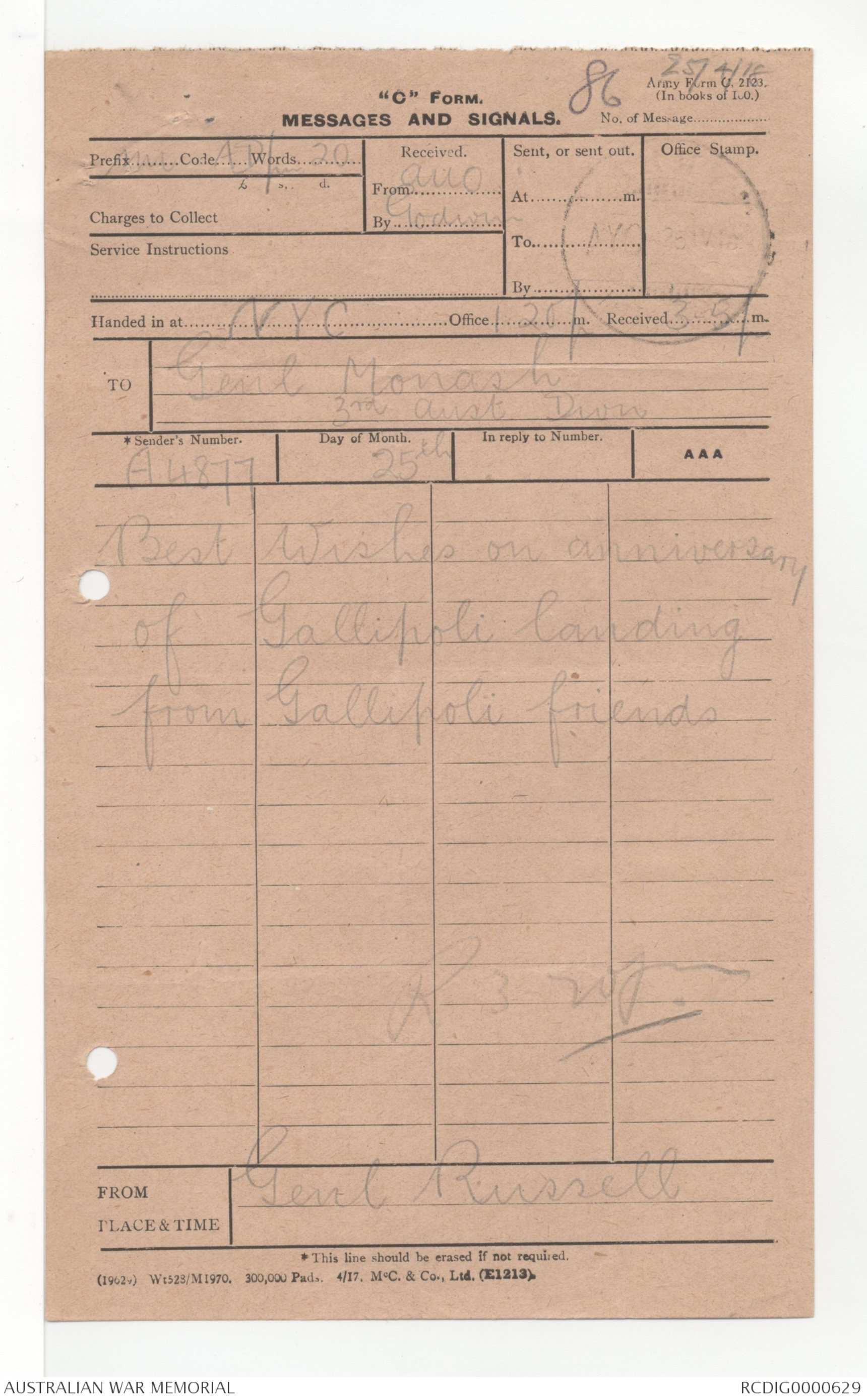
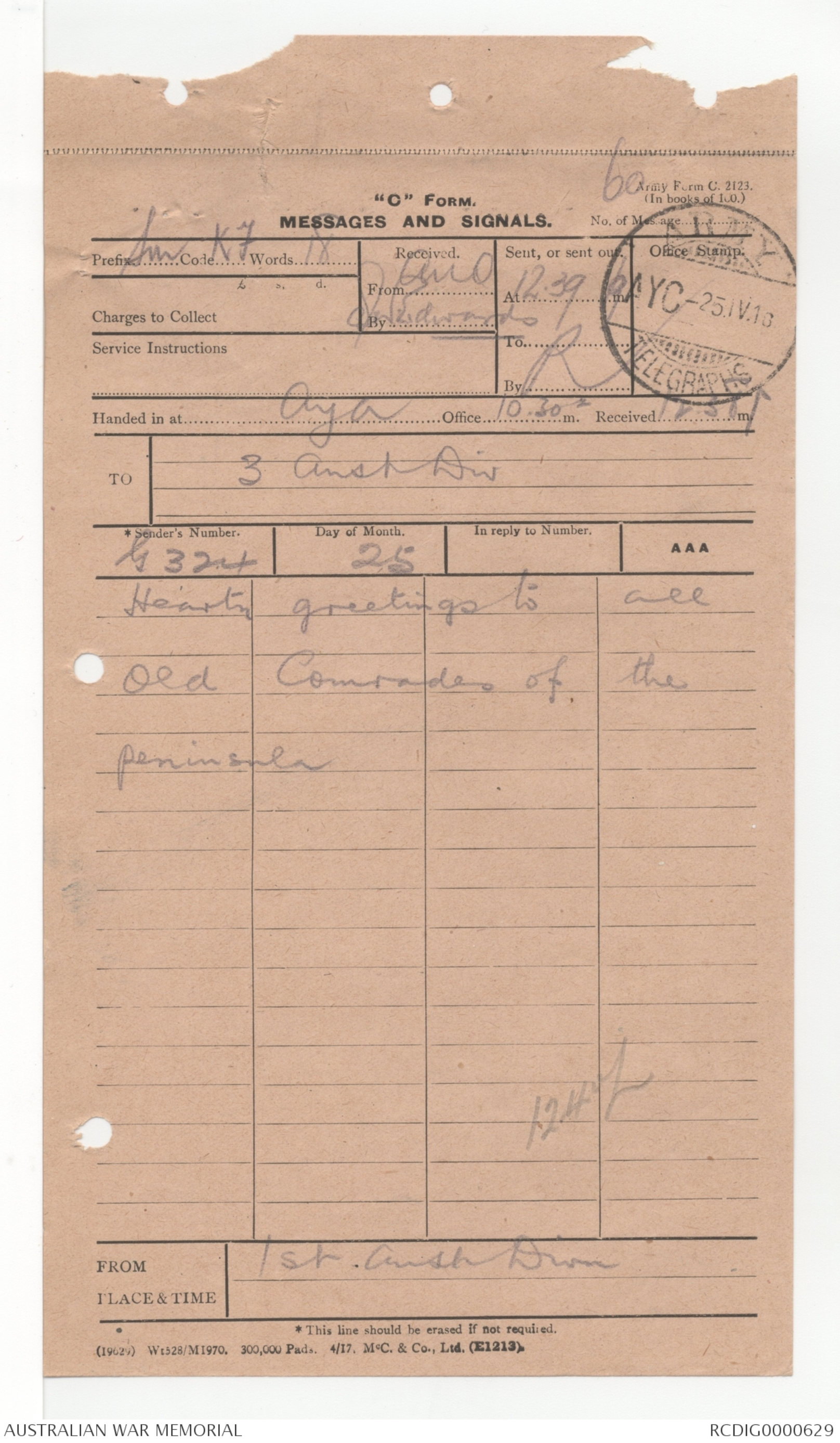
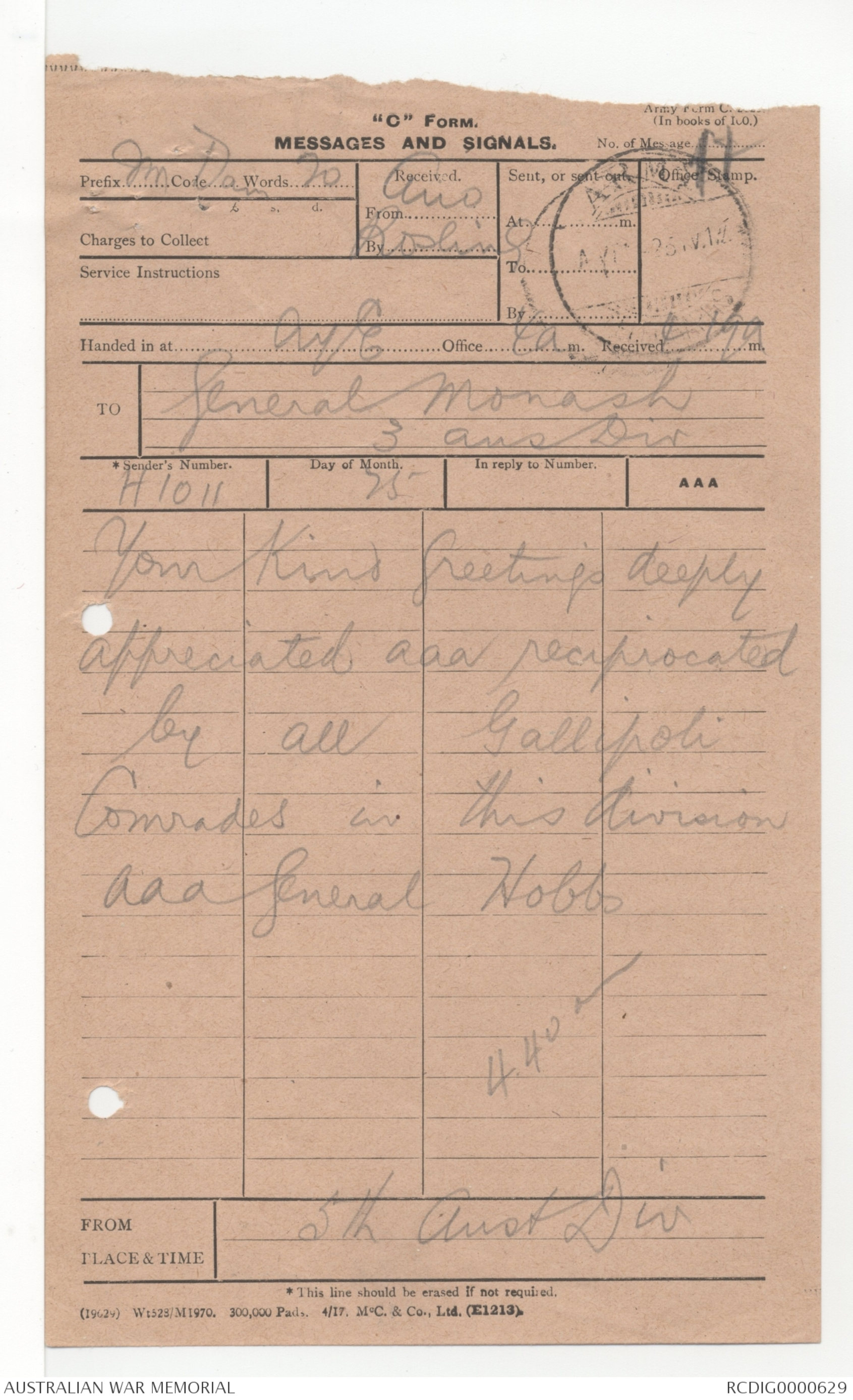
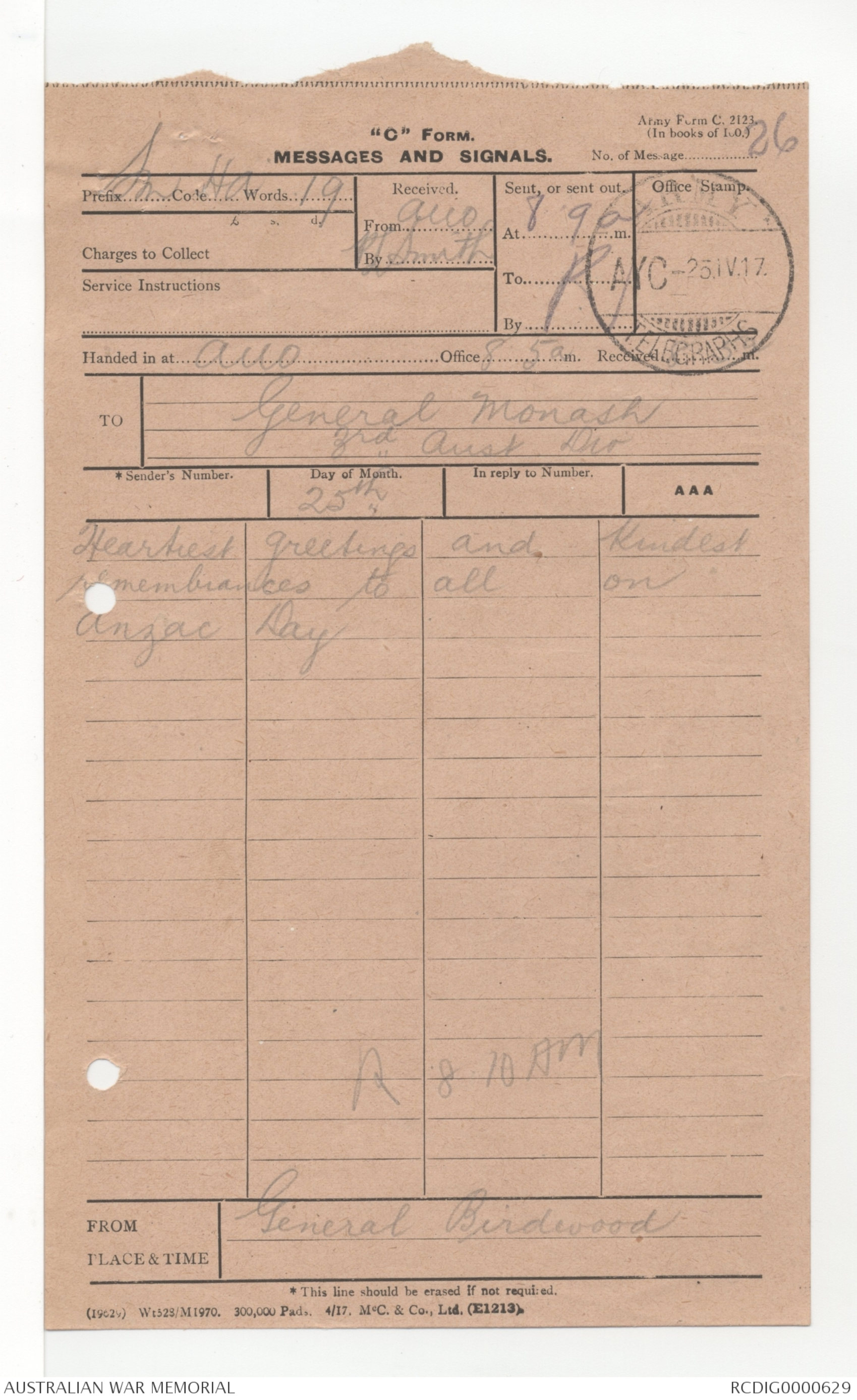

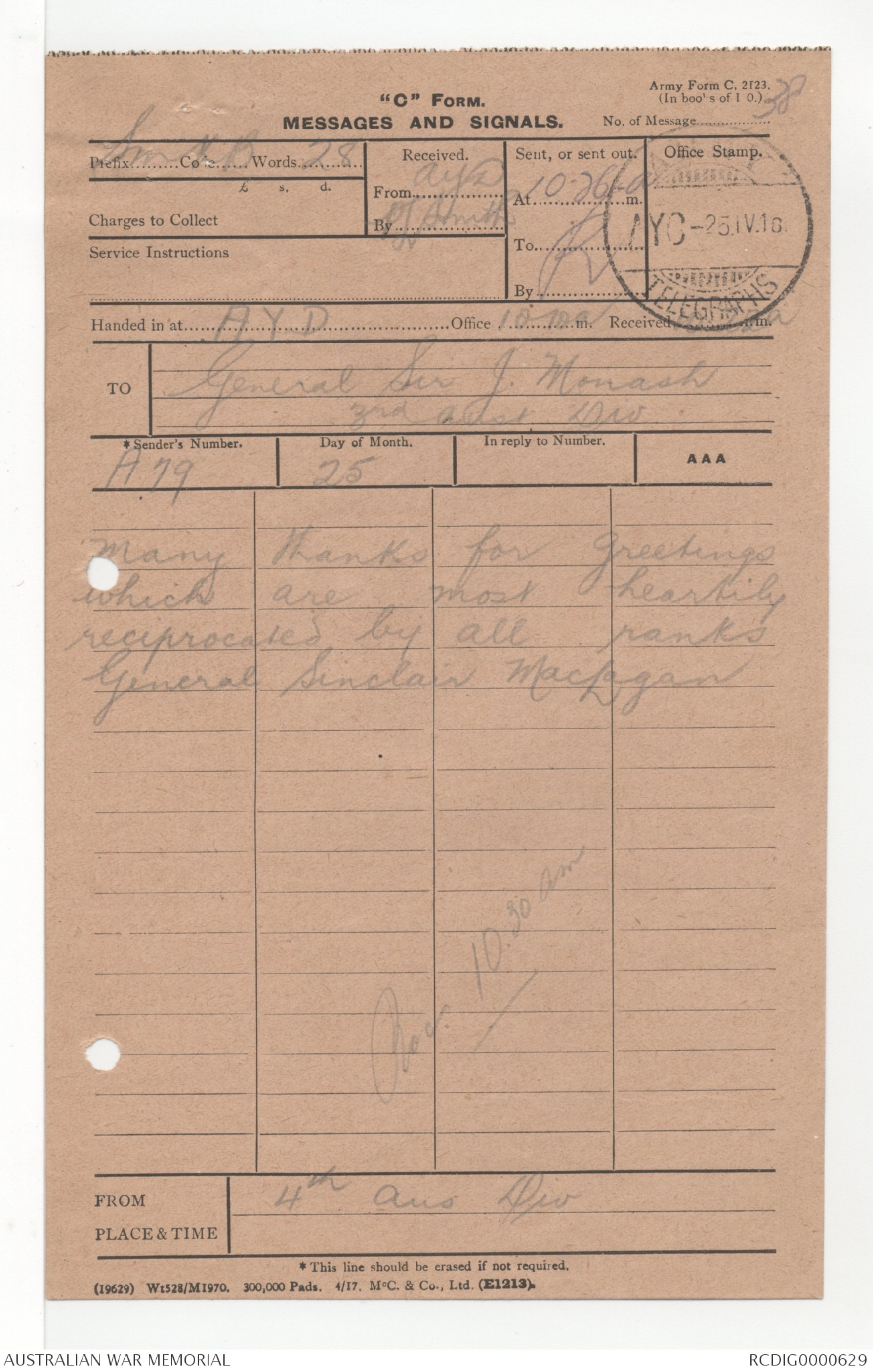
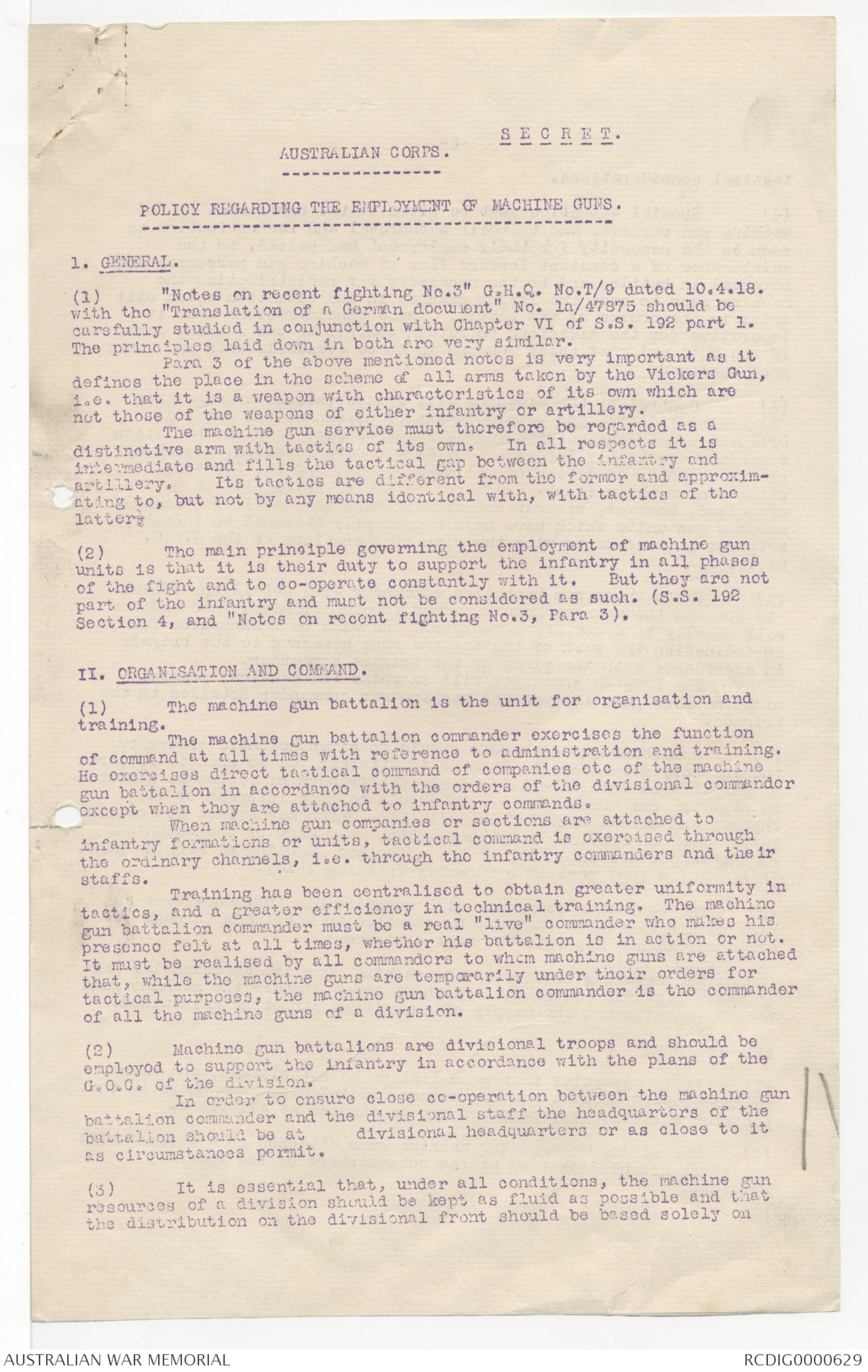

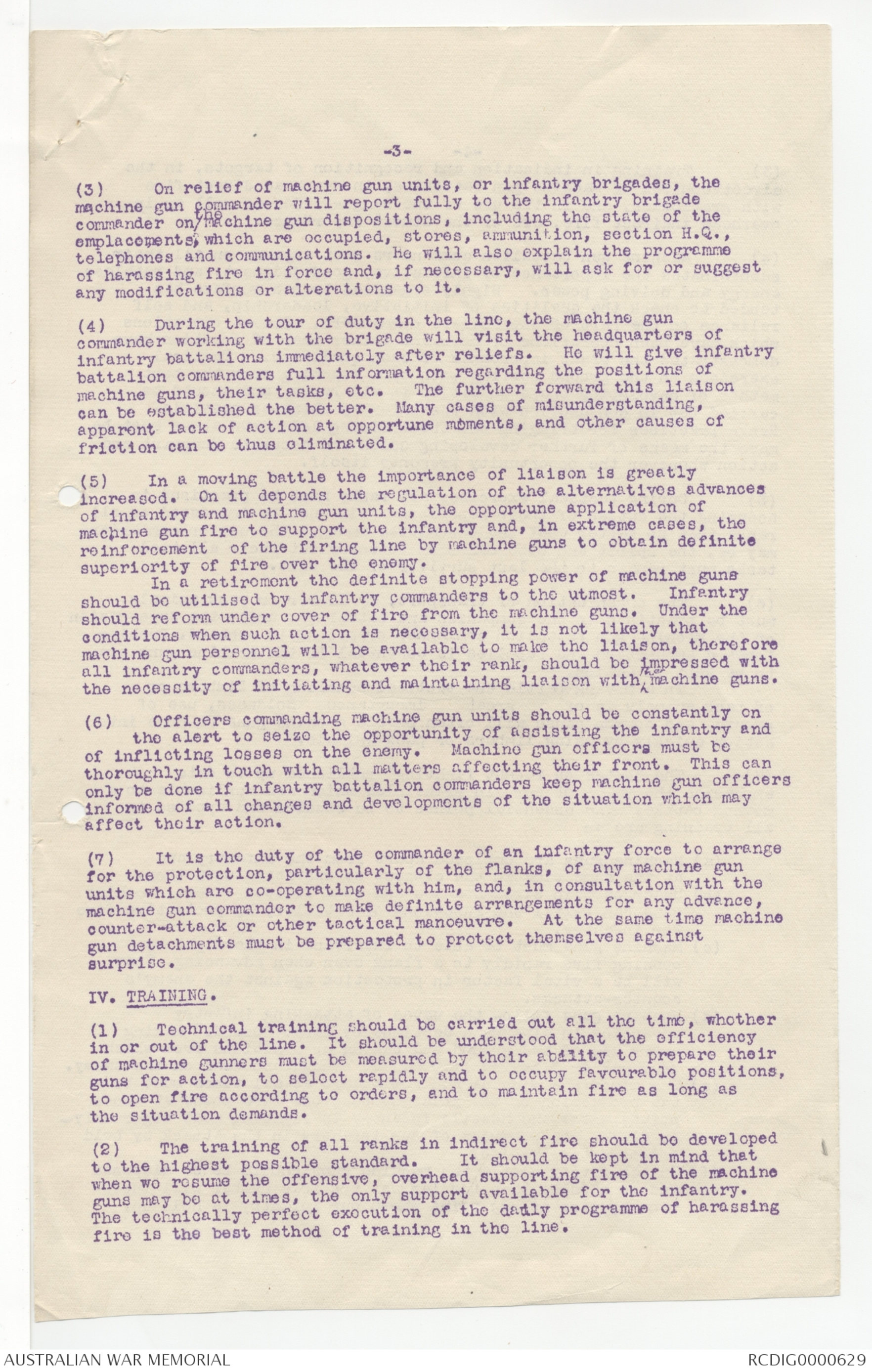
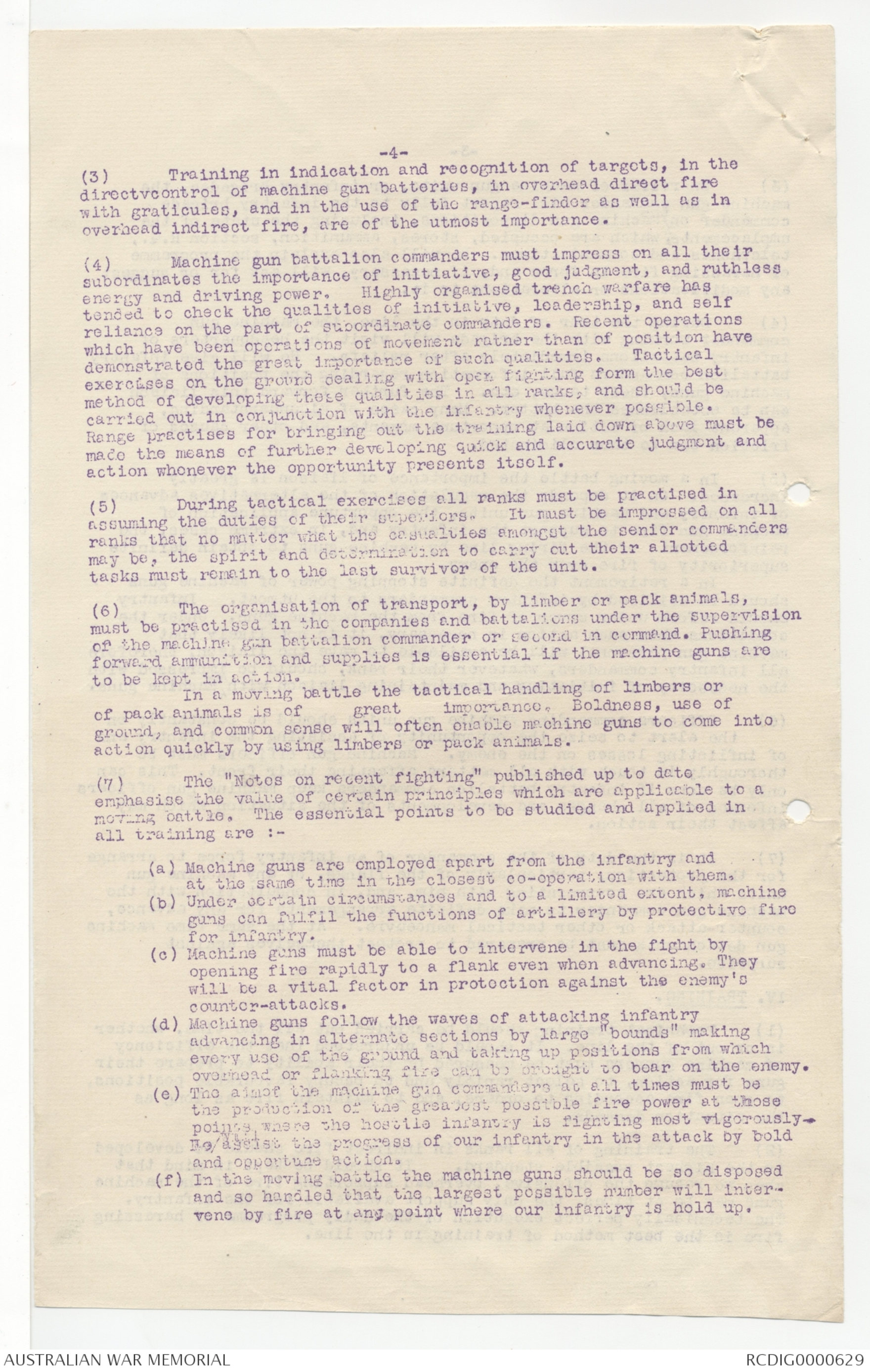
86 25/4/18
Army Form C. 2123.
(In books of 100.)
"C" FORM.
MESSAGES AND SIGNALS. No. of Message...
Prefix MM Code AD Words 20
£ s. d.
Charges to Collect
Service Instructions
Received.
From AMO
By Godwin
Sent, or sent out.
At m.
To
By
Office Stamp
Handed in at NYC Office 1.20 pm. Recd 3.5pm
TO Genl Monash
3rd Aust Divn
*Sender's Number Day of Month In reply to Number. AAA
A 4877 25th
Best Wishes on anniversary
of Gallipoli landing
from Gallipoli friends
R 3.20pm
FROM Genl Russell
PLACE & TIME
60
Army Form C. 2123.
"C" FORM.
MESSAGES AND SIGNALS. No. of Message
Prefix SM Code KF Words 18
£ s. d.
Charges to Collect
Service Instructions
Received.
From AMO
By S Edwards
Sent, or sent out.
At 12.39 pm
To
By R
Office Stamp.
[*ARMY
AYC - 25.IV.18
TELEGRAPHS*]
Handed in at AYA Office 10.30 pm Recd 12.38 pm
TO 3rd Aust Div
*Sender's Number Day of Month In reply to Number. AAA
G324 25
Hearty greetings to all
Old Comrades of the
peninsula
12.40 pm
FROM 1st Austn Divn
PLACE & TIME
Army Form C.
"C" FORM.
MESSAGES AND SIGNALS. No. of Message
Prefix JM Code Dam Words 20
£ s. d.
Charges to Collect.
Service Instructions
Received.
From AMO
By Rosling
Sent, or sent out.
At m.
To
By
Office Stamp.
[*AYC
25.VI.18
TELEGRAPHS *]
Handed in at AYE Office 4 am. Recd 4.19 am
TO General Monash
3 Aus Div
*Sender's Number Day of Month In reply to Number. AAA
H1011 25
Your Kind Greetings deeply
appreciated aaa reciprocated
by all Gallipoli
Comrades in this Division
aaa General Hobbs
4.40 am
FROM 5th Aust Div
PLACE & TIME
Army Form C. 2123.
"C" FORM.
MESSAGES AND SIGNALS. No. of Message 26
Prefix SM Code HA Words 19
£ s. d.
Charges to Collect
Service Instructions
Received.
From AMO
By H Smith
At 8.9 am
To R
By
Office Stamp.
[*ARMY
AYC-25.IV.18
TELEGRAPHS*]
Handed in at AMO Office 8.5 am. Recd
3rd Aust Div
*Sender's Number Day of Month In reply to Number. AAA
25th
Heartfelt greetings and kindest
remembrances to all on
Anzac Day
R 8.10 AM
FROM General Birdwood
PLACE & TIME
Army Form C. 2123.
"C" FORM.
MESSAGES AND SIGNALS. No. of Message 35
Prefix SM Code KA Words 9
£ s. d.
Charges to Collect
Service Instructions
Received.
From RWZ
By PL Smith
Sent, or sent out.
At 10.16 am
To
By R
Office Stamp.
[*ARMY
AYC-25.IV.18
TELEGRAPHS*]
Handed in at RWZ Office 10.5 am. Recd 10.11 am
TO General Sir J. Monash
*Sender's Number Day of Month In reply to Number. AAA
MC 34 25
Greetings third anniversary
Rec. 10.00 am
FROM McNICOLL
PLACE & TIME 10th A.I.Bde
Army Form C. 2123.
"C" FORM.
MESSAGES AND SIGNALS. No. of Message 38
Prefix SM Code KB Words 28
£ s. d.
Charges to Collect
Service Instructions
Received.
From AYD
By PL Smith
Sent, or sent out.
At 10.26 m.
To
By R
Office Stamp.
[*ARMY
AYC - 25.IV.18
TELEGRAPHS*]
Handed in at AYD Office 10.10am. Recd 10.22am
TO General Sir J. Monash
3rd Aust. Div.
*Sender's Number Day of Month In reply to Number. AAA
A79 25
Many thanks for greetings
which are most heartily
reciprocated by all ranks
General Sinclair MacLagan
Rec. 10.30 am
FROM 4th Aus Div
PLACE & TIME
SECRET.
AUSTRALIAN CORPS.
POLICY REGARDING THE EMPLOYMENT OF MACHINE GUNS.
- GENERAL
(1) "Notes on recent fighting No.3" G.H.Q. No. T/9 dated 10.4.18.
with the "Translation of a German document" No. 1a/47875 should be
carefully studied in conjunction with Chapter VI of S.S. 192 part 1.
The principles laid down in both are very familiar.
Para 3 of the above mentioned notes is very important as it
defines the place in the scheme of all arms taken by the Vickers Gun,
i.e. that it is a weapon with characteristics of its own which are
not those of the weapons of either infantry or artillery.
The machine gun service must therefore be regarded as a
distinctive arm with tactics of its own. In all respects it is
intermediate and fills the tactical gap between the infantry and
artillery. Its tactics are different from the former and approximating
to, but not by any means identical with, with tactics of the
latter.
(2) The main principle governing the employment of machine gun
units is that it is their duty to support the infantry in all phases
of the fight and to co-operate constantly with it. But they are not
part of the infantry and must not be considered as such. (S.S. 192
Section 4, and "Notes on recent fighting No.3, Para 3).
II. ORGANISATION AND COMMAND.
(1) The machine gun battalion is the unit for organisation and
training.
The machine gun battalion commander exercises the function
of command at all times with reference to administration and training.
He exercises direct tactical command of companies etc of the machine
gun battalion in accordance with the orders of the divisional commander
except when they are attached to infantry commands.
When machine gun companies or sections are attached to
infantry formations or units, tactical command is exercised through
the ordinary channels, i.e. through the infantry commanders and their
staffs.
Training has been centralised to obtain greater uniformity in
tactics, and a greater efficiency in technical training. The machine
gun battalion commander must be a real "live" commander who makes his
presence felt at all times, whether his battalion is in action or not.
It must be realised by all commanders to whom machine guns are attached
that, while the machine guns are temporarily under their orders for
tactical purposes, the machine gun battalion commander is the commander
of all the machine guns of a division.
(2) Machine gun battalions are divisional troops and should be
employed to support the infantry in accordance with the plans of the
G.O.C. of the division.
In order to ensure close co-operation between the machine gun
battalion commander and the divisional staff the headquarters of the
battalion should be at divisional headquarters or as close to it
as circumstances permit.
(3) It is essential that, under all conditions, the machine gun
resources of a division should be kept as fluid as possible and that
the distribution on the divisional front should be based solely on
-2-
tactical considerations.
(4) Special attention must be given to the engagement of
machine gun reserves and to their withdrawal and reconstitution as
soon as the necessity for their employment has passed, to the
maintenance of a constant forward flow of machine gun personnel and
material in battle, and to the necessity for redistributing the
machine guns to meet the larger changes in the situation which will
arise in the course of the battle. These considerations make it
imperative for the divisions to retain control of the machine guns,
if the full value of these weapons is to be available when and where
most required.
(5) Control by the division will always include arrangements
regarding reliefs, and reinforcement of personnel and material.
Officers commanding machine gun detachments must keep the battalion
commander constantly informed regarding orders received, movements
of detachments, condition of the detachments, and the tactical
situation on their front. Control by the division will be
exercised, however, without interfering with the tactical command of
machine gun units which have been temporarily attached to infantry
brigades in accordance with the plan of operations of the G.O.C.
Division.
(6) The machine gun battalion commander will detail an officer
to command the machine guns attached to each brigade. This officer
will usually be a company commander. He will be responsible for
co-ordinating the work of the machine guns attached to the brigade
in accordance with the plans of the brigade commander.
The brigade commander will exercise the tactical control
of the machine guns through the machine gun commander detailed to the
brigade.
(7) A machine gun commander should be given definite orders by
the infantry commander to whom he is attached as to what is required
of him, but he should be allowed as much freedom of action as possible
in carrying out these orders. He should be kept informed of all
changes and developments of the situation which may affect his action.
Initiative, enterprise, and the complete knowledge of the technique
of the weapon are essential to the effective handling of machine guns.
(See Section 160, para 13 - Infantry Training 1914).
(8) The battalion commander will exercise his influence over any
part of his battalion that may be detailed to a brigade through the
commander he has appointed to that detachment.
(9) The fighting limbers of the machine guns are an essential part
of their fighting equipment. Without these limbers the machine guns
become immobile and the supply of ammunition cannot be maintained.
III. LIAISON.
(1) It is essential that good liaison be established, and maintained
between machine gun commanders and infantry commanders so that
the most effective co-operation may be ensured at all times.
(2) The officer commanding machine guns attached to a brigade will
establish his headquarters at the headquarters of the infantry
brigade.
-3-
(3) On relief of machine gun units, or infantry brigades, the
machine gun commander will report fully to the infantry brigade
commander on ∧ the machine gun dispositions, including the state of the
emplacements, which are occupied, stores, ammunition, section H.Q.,
telephones and communications. He will also explain the programme
of harassing fire in force and, if necessary, will ask for or suggest
any modifications or alterations to it.
(4) During the tour of duty in the line, the machine gun
commander working with the brigade will visit the headquarters of
infantry battalions immediately after reliefs. He will give infantry
battalion commanders full information regarding the positions of
machine guns, their tasks etc. The further forward this liaison
can be established the better. Many cases of misunderstanding,
apparent lack of action at opportune moments, and other causes of
friction can be thus eliminated.
(5) In a moving battle the importance of liaison is greatly
increased. On it depends the regulation of the alternative advances
of infantry and machine gun units, the opportune application of
machine gun fire to support the infantry and, in extreme cases, the
reinforcement of the firing line by machine guns to obtain definite
superiority of fire over the enemy
In a retirement the definite stopping power of machine guns
should be utilised by infantry commanders to the utmost. Infantry
should reform under cover of fire from the machine guns. Under the
conditions when such action is necessary, it is not likely that
machine gun personnel will be available to make the liaison, therefore
all infantry commanders, whatever their rank, should be impressed with
the necessity of initiating and maintaining liaison with ∧ their machine guns.
(6) Officers commanding machine gun units should be constantly on
the alert to seize the opportunity of assisting the infantry and
of inflicting losses on the enemy. Machine gun officers must be
thoroughly in touch with all matters affecting their front. This can
only be done if infantry battalion commanders keep machine gun officers
informed of all changes and developments of the situation which may
affect their action.
(7) It is the duty of the commander of an infantry force to arrange
for the protection, particularly of the flanks, of any machine gun
units which are co-operating with him, and, in consultation with the
machine gun commander to make definite arrangements for any advance,
counter-attack or other tactical manoeuvre. At the same time machine
gun detachments must be prepared to protect themselves against
surprise.
1V. TRAINING
(1) Technical training should be carried out all the time, whether
in or out of the line. It should be understood that the efficiency
of machine gunners must be measured by their ability to prepare their
guns for action, to select rapidly and to occupy favourable positions,
to open fire according to orders, and to maintain fire as long as
the situation demands.
(2) The training of all ranks in indirect fire should be developed
to the highest possible standard. It should be kept in mind that
when we resume the offensive, overhead supporting fire of the machine
guns may be at times, the only support available for the infantry.
The technically perfect execution of the daily programme of harassing
fire is the best method of training in the line.
-4-
(3) Training in indication and recognition of targets, in the
directvcontrol of machine gun batteries, in overhead direct fire
with graticules, and in the use of the range-finder as well as in
overhead indirect fire, are of the utmost importance.
(4) Machine gun battalion commanders must impress on all their
subordinates the importance of initiative, good judgement, and ruthless
energy and driving power. Highly organised trench warfare has
tended to check the qualities of initiative, leadership, and self
reliance on the part of subordinate commanders. Recent operations
which have been operations of movement rather than of position have
demonstrated the great importance of such qualities. Tactical
exercises on the ground dealing with open fighting form the best
method of developing these qualities in all ranks, and should be
carried out in conjunction with the infantry whenever possible.
Range practises for bringing out the training laid down above must be
made the means of further developing quick and accurate judgement and
action whenever the opportunity presents itself.
(5) During tactical exercises all ranks must practised in
assuming the duties of their superiors. It must be impressed on all
ranks that no matter what the casualties amongst the senior commanders
may be, the spirit and determination to carry out their allotted
tasks must remain to the last survivor of the unit.
(6) The organisation of transport, by limber or pack animals,
must be practised in the companies and battalions under the supervision
of the machine gun commander or second in command. Pushing
forward ammunition and supplies is essential if the machine guns are
to be kept in action.
In a moving battle the tactical handling of limbers or
pack animals is of great importance. Boldness, use of
ground, and common sense will often enable machine guns to come into
action quickly by using limbers or pack animals.
(7) The "Notes on recent fighting" published up to date
emphasise the value of certain principles which are applicable to a
moving battle. The essential points to be studied and applied in
all training are :-
(a) Machine guns are employed apart from the infantry and
at the same time in the closest co-operation with them.
(b) Under certain circumstances and to a limited extent, machine
guns can fulfil the functions of artillery by protective fire
for infantry.
(c) Machine guns must be able to intervene in the fight by
opening fire rapidly to a flank even when advancing. They
will be a vital factor in protection against the enemy's
counter-attacks.
(d) Machine guns follow the waves of attacking infantry
advancing in alternate sections by large "bounds" making
every use of the ground and taking up positions from which
overhead or flanking fire can be brought to bear on the enemy.
(e) The aimof the machine gun commanders at all times must be
the production of the greatest possible fire power at those
points where the hostile infantry is fighting most vigorously-
He ∧ will assist the progress of our infantry in the attack by bold
and opportune action.
(f) In the moving battle the machine guns should be so disposed
and so handled that the largest possible number will intervene
by fire at any point where our infantry is hold up.
 Sam scott
Sam scottThis transcription item is now locked to you for editing. To release the lock either Save your changes or Cancel.
This lock will be automatically released after 60 minutes of inactivity.